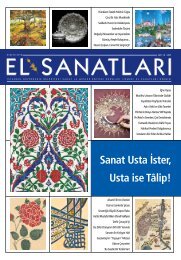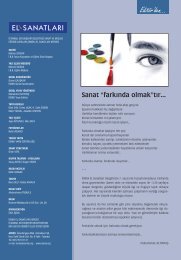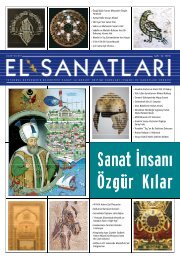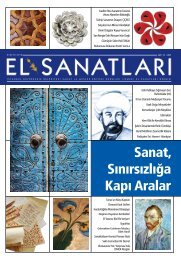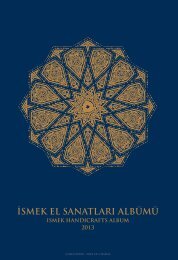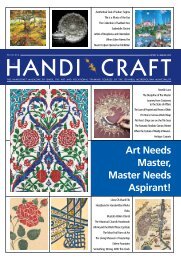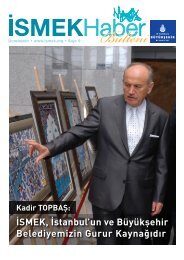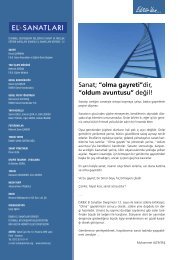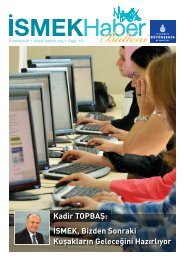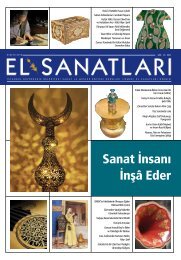An Overview of Written Sourcesin Ottoman EthnographyAs is known, with Topkapi Palace Museum RecordNo. D. 97067/5804, dated 1525, notebook 3, documentingmasters organized in palace and their products,reached from Ottoman Empire period today.Such that notebook, Ehl-i Hiref notebooks 4 ,havinginformation about palace records, works of artificersand masters, dated 1640 Narh Notebook 5,including quality and quantity and prices of itemsproduced for people outside the palace, official documentsprotected by some establishments are creatingvaluable written sources. Among them, documentsin Republic of Turkey Prime Ministry GeneralDirectorate of State Archives, General Directorate ofOttoman Archive, such as Firmans 6, Irade, charter,muhime notebooks, establishment of Evkaf-i Humayunin 1255 (1839 Chr.), after this date Meclis-i Vasla,Bab-i Ali Document room Sadaret Papers and EvkafIrade 7 taking place of Hatt-i Humayun draw attention.Except from this archive, there is information indocuments in Topkapi Palace Archive, in DirectorateGeneral of Foundations Archive, Istanbul Office ofMufti Ser’iyye (Qadi) Registers Archive. Samples canbe given to publications made in accordance with thesearch of this papers.8 The Seyahatname of EvliyaCelebi can be belonged to 17th Century.Ser’iyye Registers (Qadi Registers)Importance of Tereke UnitsIn this sense Qadi Registers in Istanbul Office of MuftiSer’iyye Registers Archive which belong to courtssuch as Uskudar, Istanbul, Bab, Galata, Eyup, Balat,Haskoy, Rumeli Sadaret, create important writtensources. The same situation is matter of notebooksprotected in places such as Prime Ministry OttomanArchive. This is handling the same time period andthe dates after them, Istanbul and outside Istanbul9. It is about different time periods cities such as Bolu10, Antalya 11, together with Qadi Registers (Ser’iyyeRegisters), some of them were published, regardingCommunity of Ehl-i Hiref of 18th Century. Moresamples can be given.Material cultural products, in units of Qadi Registerssuch as tereke, muhallefat, hibe etc., are completinginformation derived from extant objective samples.They enlighten Ottoman Ethnography from the beginningof 16th Century. These include valuable informationabout especially extant objective samplesfrom outside the palace, quality and quantity ofportable material cultural items belongs to 16th and17th century and terminology.114The cupboards in the archives of the registers that belong to the Mufti Office of Istanbulare valuable also because they were made in the hands of Sultan Abdulhamid the 2nd.
What we aimed in this article is that: Specifyingof material cultural items used by people fromoutside the palace in 16th and 17th centuries, inQadi Registers, Uskudar Law Court with number1,2,5,9,14,17,26,51,56,84 and Istanbul Law Court withnumber 3,12,18 and Eyup Law Court with number 74.They have been prepared by Turkish Religious FoundationCentre for Islamic Studies, published in cooperationwith Istanbul 2010 Europe Capital of CultureAgency. Another aim is to make literary review of agroup of noun phrase, and terminology under titlessuch as tereke, muhallefat, hibe etc. and to take theinitiative to prepare a database for written source supportingobjective sources in Ottoman Ethnographystudies. Article is restricted 15 by Uskudar Law Courtwith number 1,2,5,9,14,17,26,51,56,84, dated 16thCentury, with number 3,12,18 and Eyup Law Courtwith number 74, dated 17th Century Qadi Registers,prepared by Turkish Religious Foundation Centre forIslamic Studies, Istanbul Law Court, published in cooperationwith Istanbul 2010 Europe Capital of CultureAgency. It includes some terminology and nounphrases about material cultural items.16th CenturyWoodwork: wooden dish, round wooden brass,wooden plate, board saw, barrel, ironmongery basket,stool, coffer, basket, kneading troughGlazingwork: Glass, bottleLeatherwork: Bergama baboosh, a pair of modelbaboosh, boot, Gekvize baboosh ma'a edik, ic eduk,mesh, buff, baboosh, baboosh eduk, sandik-i baboosh,yellow baboosh, three little modelsWeavingwork:Coloured weavingworks: Basma package, basmacushion , basma pillow, basma blanket, colouredkepenek, red basma, yemeni blanketHome textile products: package, bed lining, dosek,dosek with two sides , pillow with two sides, sekerparecushion , pillow, blanket , pillow for face.Clothes: Agriz kaftan, ak cember,ak kaftan, ak saya,alaca destimal, alaca pestamal, aseli, asumani kapama,avare, cuha kaftan, basma cember, bas bezi, beldolamasi, bez kaftan, boyali bez, bork, burgu, buruncekcember, big makreme, cubbe, caksir, cekmecaksir, cember, cuha kaftan, destimal, dolama kaftan,don, gloves, futa, gok kaftan, gok bez kaftan, shirt,shirt for hamam, hamayil, ibrisim kusak, kaban, kaftan
- Page 1:
Art Leads Oneto Eternity!
- Page 4 and 5:
In ThisEdition1506The StringentMast
- Page 6:
Dear Istanbulians,After the industr
- Page 10 and 11:
One Marbler Has Carried This Colorf
- Page 12 and 13:
this art”. Being single those day
- Page 14 and 15:
in flower marbling.” He says, and
- Page 16 and 17:
Cicek Derman: The DoyenneFlower of
- Page 18 and 19:
and does not want her to either stu
- Page 20 and 21:
der the very inside of you.” She
- Page 22 and 23:
ate” at all. The creator is one,
- Page 25 and 26:
Kundekâri:The Time Defying Heritag
- Page 27:
Cracks and incisions which could oc
- Page 30 and 31:
land to understand weather he can p
- Page 32 and 33:
When Deep WavesWash Ashore!by A. Ul
- Page 34 and 35:
'Bismillah' by Omer Faruk Deretaste
- Page 36 and 37:
'The Asr Surah' by Mustafa Cemil Ef
- Page 38 and 39:
Van Gogh,The Genious Painter of Yel
- Page 40 and 41:
and anxieties that surrounded him s
- Page 42 and 43:
The most prominent features which w
- Page 44 and 45:
Starry Night Over the Rhonehe opted
- Page 46 and 47:
the left side of his face is a colo
- Page 48 and 49:
The Threaded Version of Silver isRe
- Page 50 and 51:
out from a narrower hole. Theseoper
- Page 52 and 53:
Sumi-e: The Elegance which Comesint
- Page 54 and 55:
traditions, perform this art seated
- Page 56 and 57:
sumed in half an hour after it is p
- Page 59 and 60:
er in ISMEK, after her illumination
- Page 61 and 62:
59Illustration: Hatice Ozturk
- Page 63 and 64:
there was a captures chamberlain. 5
- Page 65 and 66: lack sides. As far as I can see del
- Page 67 and 68: One of the founders of the civilisa
- Page 69 and 70: The miniature by Ochiai Yoshiiku da
- Page 71 and 72: Miniatures are in the Irony of West
- Page 73 and 74: pictions of various countries, coul
- Page 75 and 76: A miniature example from the work n
- Page 77 and 78: “Ve mâ rameyte iz rameyte ve lak
- Page 79 and 80: usually there is a part consisting
- Page 81 and 82: When applied on wood, Edirnekâri c
- Page 83 and 84: What is very distinct regardingthe
- Page 85 and 86: The ceiling decorations, corner cab
- Page 87 and 88: There is an epigram for the Artof C
- Page 89 and 90: If the paper had spoken and told wh
- Page 91 and 92: nailing, gluing or compressing of t
- Page 93 and 94: gold. The notebooks with gold leave
- Page 95 and 96: laminary and get the required thick
- Page 97 and 98: Both the insufficience of green fie
- Page 100 and 101: 15 years ago, Mr. Yesilce allocated
- Page 102 and 103: On the Zoomorphic1Originsof the Rum
- Page 104 and 105: Shape-6Shape-13another finding foun
- Page 106 and 107: The Harem in the Topkapi Palace,The
- Page 108 and 109: very much like the school of boys i
- Page 110 and 111: The Blue Doors of TunisiaThe Articl
- Page 112 and 113: Tunisia is the pearl of the Mediter
- Page 114 and 115: Ottoman CultureProducts from Qadi R
- Page 118 and 119: Signature of Abdulhamit II on the c
- Page 120 and 121: Pieces of Wastepapers TurnInto Jewe
- Page 122 and 123: in a short time, we ask him to make
- Page 124 and 125: Symbols of theLife of Thoughtby Pro
- Page 126 and 127: The Gulpayegan Masjid Kufi writing
- Page 128 and 129: which show some of the monumental w
- Page 130 and 131: An appearance from the interior of
- Page 132 and 133: The Kufic script at the top is prep
- Page 134 and 135: in yerinize grafologla konusuverir.
- Page 136 and 137: considered as a hard science rather
- Page 138 and 139: Zeynep Bornovali states that differ
- Page 140 and 141: The Dance of the Needle with Cerami
- Page 142 and 143: was not the case, however, for the
- Page 144 and 145: an area determined on the material
- Page 146 and 147: Dilek Hanif: A Fashion DesignerWho
- Page 148 and 149: others prefer to have a single and
- Page 150 and 151: Princess Nazli:The Patron of Arts a
- Page 152 and 153: which was also known as “Villa He
- Page 154 and 155: A Bouquet From the Hidden Paradiseb
- Page 156 and 157: Canfeza (Heart touching) A fully st
- Page 158 and 159: “Someone whom I hadn’t met befo
- Page 160 and 161: The Storm of ISMEK Blowingin the In
- Page 162: Menaf Nam's work which was awarded



